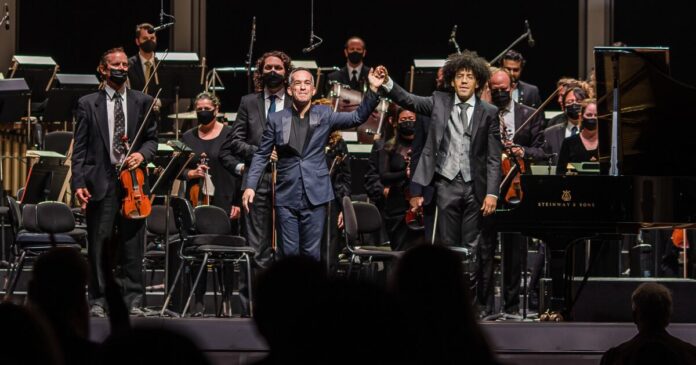You have to go back to an arcane musicology article from 1957 to find the source of the question, “When is a concerto not a concerto?”
The original query, part of a scholarly etymological excavation of the actual term “concerto,” has since been recruited (along with a host of other epithets) to describe Brahms’ second Piano Concerto. Indeed, this piece has long defied easy categorization — is it a symphony with a piano? A concerto with a symphonic complex? Genre notwithstanding, the work was given a deep and satisfying reading Saturday evening by Rafael Payare and the San Diego Symphony, with Inon Barnatan as soloist.
At every turn, the work operates cagily, using ideas as foils: the opening pastoral horn theme belies the later descent into a dark and terrifying virtuosity that challenged even the composer as soloist; expansive, meadows of gentle sonority conceal an intense, architectural motivic development.
These contradictions were maximized and celebrated by Payare, Barnatan, and members of the orchestra. Detours into arcadian groves of wind sonority were blended and carefully shaped in the first movement. Surging waves of strings in the scherzo were detailed and powerful beneath Barnatan’s grand chordal calls. The interplay between Payare and soloist was immediate and palpable, as if the two musicians share an established intimacy. The scherzo’s trio section seems borrowed from Beethoven: a giant misfiring hurdy-gurdy, punctuated by horn blasts and disjunct string gestures.
Barnatan possesses a virtuosity that can disturb equilibrium, rising suddenly from moments of carefully-crafted tenderness, as in the gentle Andante, with its famous opening cello solo finely played by Yao Zhao. Barnatan made Brahms’ ubiquitous hemiola rhythms sound new, rising to rhapsodic heights, and then receding into spectral pointillism beneath a ghostly wind chorale.
The fourth movement Allegro Grazioso keeps with the idea of using extremes of one character to make the most of another: the initial gambit is one of light but menacing mischief, with compartmentalized, episodic melodies, only occasionally giving over to a series of dazzling pianistic ideas — a virtuosity that seems to exist in spite of the character of opening moments. Barnatan impressed with his knowing command of, and service to, this work.
Dvorak’s Seventh Symphony operates in a similar fashion, using our initial mistaken impressions of textures and melodies to make the most of their later versions. The first movement begins with a miniature, brooding sound — almost as tragic incidental music, before launching into a driving but understated seriousness, the orchestral never really flowering until well after the lyrical second theme. Dvorak is, even more than his friend Brahms, at all times melody-driven, and the evolution of melodic character moves us through his structures. For this you need an ensemble with sectional integrity to clarify his detailed orchestrational variations, and the orchestra beneath Payare did not disappoint. The Seventh moves between quasi-chamber music polyphony and grand collective declamations; the strings were unified and balanced, punctuated by walls of stalwart brass and limpid choirs of winds, who were especially polished in the gentle song of the Poco Adagio.
Payare has a gift for bringing out embedded dance rhythms — found everywhere in Dvorak — and even through wild tempo changes, the group moved in easy unity. The Scherzo is a character essay in group syncopation and counterpoint under the ever-present melodic line. The immediacy of string accents and the ability of the orchestra to negotiate a changing landscape of instrumental characterizations brought out the dramatic vibrance of Dvorak’s Bohemian identity.
Gity Razaz’s “Methuselah (In Chains of Time)” received an auspicious world premiere Saturday. Razaz has a compelling voice and refreshing command of sonority and harmony. Highly charged fragments of tonally suggestive melodies, each on the verge of zipping off into space, are yolked together and anchored in sustained drones of harmonic semi-light. Brilliant use of orchestral color and a careful shaping of foreground and background ideas create an opulent and suggestive sonic landscape. The percussion were especially captivating in her piece, with mallet instruments and auxiliary sounds played expertly and with a great advocacy of her music.
Schulze is a freelance writer.




